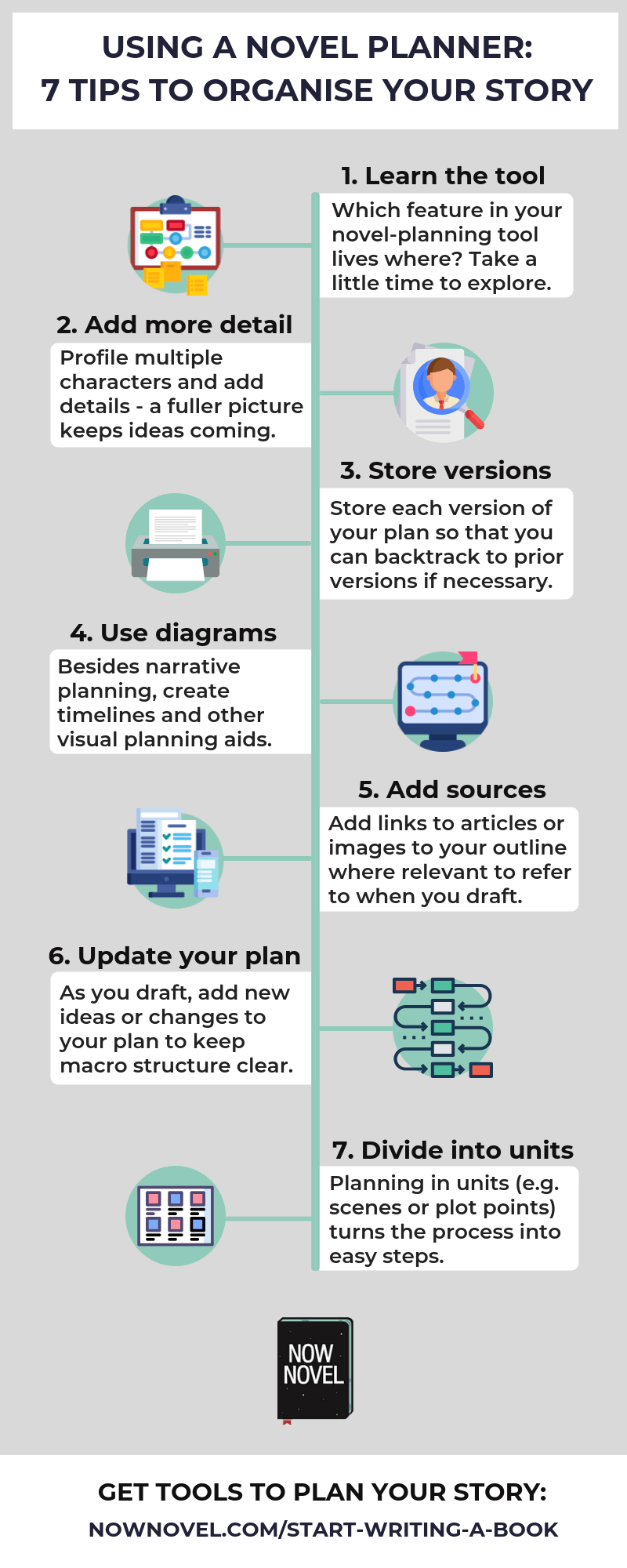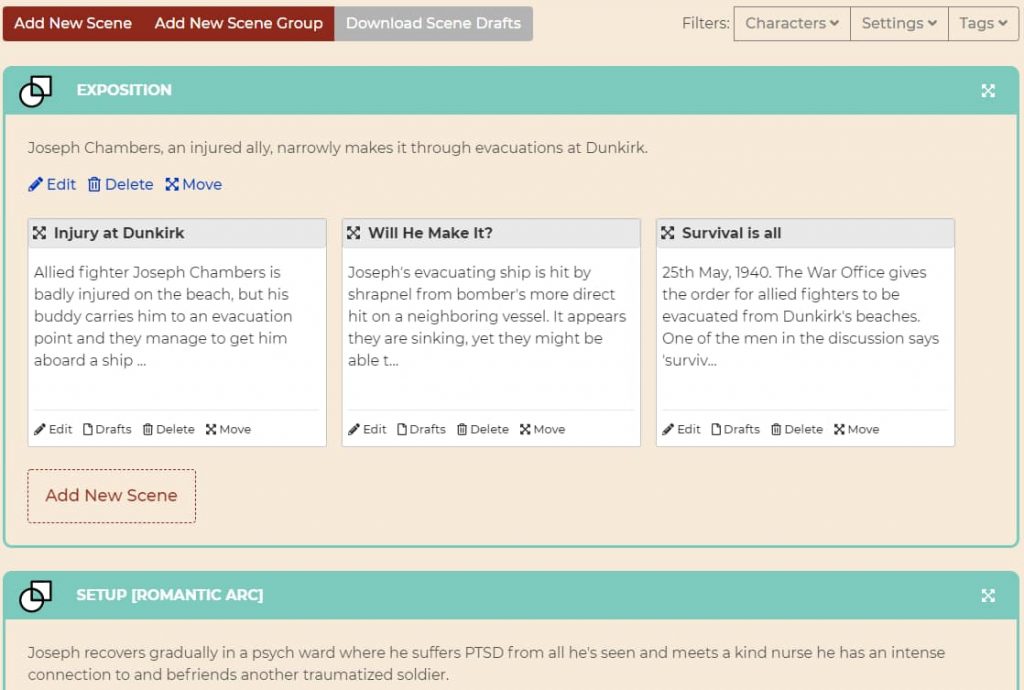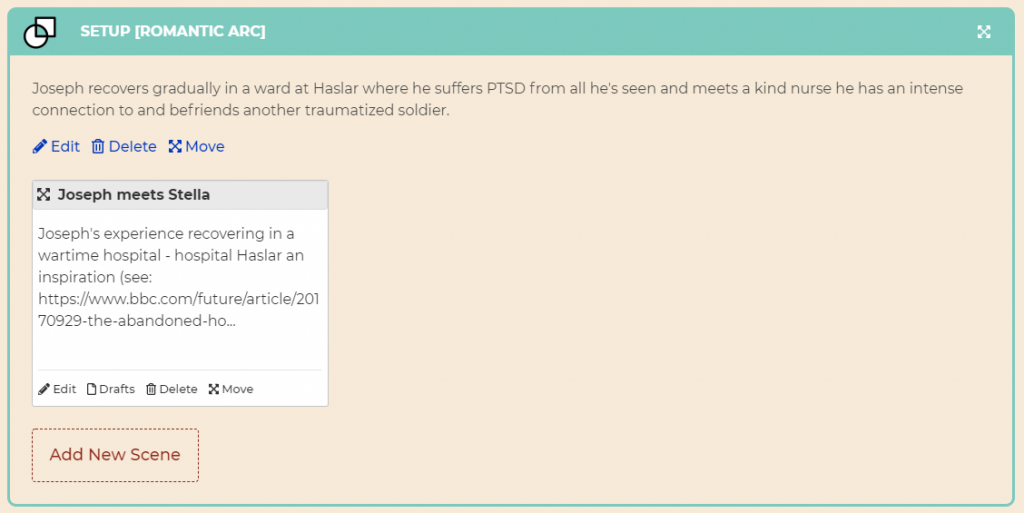Using novel planner tools helps you build a story with purpose. Whether you use a step-by-step, prompted outlining process like Now Novel's dashboard or other story software, try these tips to for planning and making progress:
Making better story progress with planning tools: 7 tips
- Set aside time to learn your novel planner
- Plan and brainstorm in detail, with purpose
- Keep versions of your story plan
- Use visual diagrams, too
- Incorporate inspiring secondary sources
- Update your story plan as you draft
- Structure your outlining into manageable units
Let's dig deeper into these novel planning ideas:
1. Set aside time to learn your novel planner
For any creative software, there is a learning curve. Some curves are steeper than others, depending on your writing tools' features.
Set aside half an hour to just explore your novel planning tool's interface and poke around. What does each feature do and how could it benefit your story-planning?
If you have any questions or doubts about your story planner, reach out and ask the creators. Not only will you get a personal answer: You'll also help your writing tool's developers understand what could be simpler and more self-explanatory.
Thanks to this feedback loop, our own browser-based novel outlining tools have been through two major iterations and other member-requested 'quality of life' upgrades.
2. Plan and brainstorm in detail, with purpose
What do you need to know to feel comfortable to start writing your first draft?
This differs for each writer. Some of us want profiles for every character, character questionnaires, a one-page summary of every planned story setting.
Others need bare bones - a main character and their initial goal and its motivation, plus an idea for a conflict they will encounter as their journey gets underway.
Getting on a roll with planning has benefits - you get into the habit of creating, inventing, drawing lines in the sand.
If you've created one character outline (for example, detailing your protagonist and their appearance and goals), try to create another while motivated and the creative side of your brain is fired up.
Our own anonymized data has shown that writers who outline more elements of their story upfront tend to persevere further with their WIP.
It's helpful to begin with a fuller mental picture of the personalities and places that will fill your story's pages.
3. Keep versions of your story plan
Many designers do this, in case they want to backtrack on their changes. Musicians too.
Ideas are fleeting. Sometimes you change part of your WIP a little more than you intended, and the next thing you're floundering for how to proceed.
Print out what you have outlined or brainstormed so far periodically (or save a digital file if you prefer to minimize waste).
Keep simplified, bullet-list record of changes to your story plan with the date, too. That way, you can go back to an earlier version of your outline whenever you want or need. You could name outline version by date and change increment, e.g. 'Romance WIP, V2.'
In the Now Novel dashboard, you can download your outline in PDF format at any stage of the process, paginated with the current date in the footer. This makes it easy to keep track of which version is the latest (and your favorite variation on your initial story themes).

4. Use visual diagrams, too
Writing down ideas and fragments of ideas and characters is useful. In so doing, you nudge the pieces of your story to come together.
Yet there are times when all the text you've accumulated may feel overwhelming. Visual diagrams provide a helpful way to map out story structure.
Streamline and simplify your organizing by creating visual diagrams of your story. These could be:
- Post-its with single-sentence, action-based chapter summaries arranged on a board (e.g. 'Detective Wren is called into Dobsonville')
- Timelines of events (either scene-by-scene or chapter-by-chapter)
- A rough map of locations in your story's world
- Graphs tracing the ups and downs of rising and falling plot points affecting your characters
These macro-level planning exercises help to maintain a bird's eye perspective while you're wading through the ground-level complexities of your draft.

Tour our story outlining tools and learn more about the benefits that come with Now Novel membership.
5. Incorporate inspiring secondary sources
When using a novel planner like our story dashboard, feel free to include links and notes as you go.
You may find, for example, while brainstorming a core part of your story such as the setup of a romantic arc that an educational article gives you ideas for details about your characters' daily lives.

Adding a link at this point in your outline is a useful way to keep track of secondary inspirations to draw on when drafting you actual scenes.
6. Update your story plan as you draft
Often we approach outlining and drafting as linear processes, the first leading into the second.
Once you've created a guiding novel plan, it's often helpful to keep updating it as you draft if anything significant changes.
This may be something small, such as a character's name. Or it could be a major plot point alteration. Or else you may wish to profile a new character who has emerged as you draft a specific scene.
Updating your story plan alongside your active story draft will ensure you have a macro-structure document that maps to the details of your story.
This way you can dip out of the detail-level view at any time, falcon-like, to see your whole story sprawling with only the salient details for further organizing visible.
7. Structure your outlining into manageable units
One of the perks of using a novel planner such as the Now Novel dashboard is being able to focus on one element at a time. To break down the complex story planning process into manageable tasks. As Now Novel member David said, this allows you to:
'...mine out the ideas and concepts ... [and] develop the book ... in a systematic approach'
You could start by brainstorming individual character arcs or plot points. For example, incidents that bring characters closer to their goals or create obstacles between them and their goals. In the 'Core Plot' section of Now Novel's story dashboard, we've called the former 'rising plot points' and the latter 'falling plot points'.
Instead of trying to imagine your entire story and how every detail plays out in one swoop, this will make your planning process more manageable.
Need tools to plan your novel? Try the first two steps of The Process now, and get unlimited access, weekly editor critiques, and monthly coach Q&As when you upgrade.










